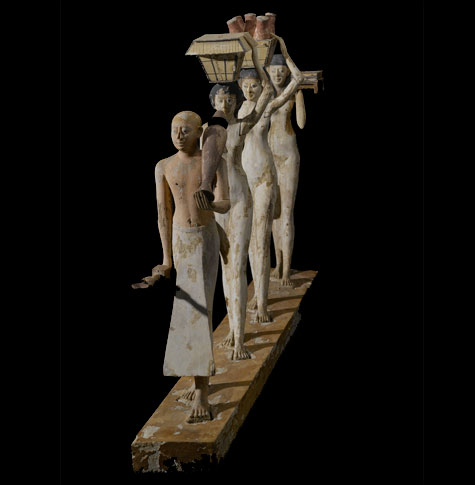
PROCESSION OF OFFERING BEARERS: The objects from Tomb 10A were meant to be magic talismans that would come alive to serve the dead in the afterlife.
VIEW: More photos from "Secrets of Tomb 10A" |
In 1915, Harvard University and Museum of Fine Arts archæologists digging in a rocky cliff at Deir el-Bersha unearthed the 4000-year-old tomb of the Djehutynakhts, an ancient Egyptian governor and his wife. Thieves had long ago ransacked the crypt, sweeping wooden models of boating and farming into jumbled heaps beside the coffins, dismembering the mummies, making off with jewels. A torso was propped in a corner. A head rested atop a casket.The Boston team carefully packed up the treasures that remained. The works survived a ship fire on the way here, only to be placed in storage for generations. “Secrets of Tomb 10A: Egypt 2000 BC” at the MFA is the first time most of the 200 objects will have gone on public view.
The MFA wreaths the exhibit in exclamations. One coffin is deemed an “unparalleled masterpiece of Middle Kingdom painting.” “No other Middle Kingdom tomb uncovered to date has yielded so many models,” we’re told. A carved procession of offering bearers is “the finest model of any kind discovered at any site.” The artifacts are at full stretch to fill the sprawling Gund Gallery — to be an “important” show — but the best work does live up to the hype.
MFA curators Rita Freed, Lawrence Berman, Denise Doxey, and Nicholas Picardo offer a sense of the tomb, directing you from the spacious opening gallery into a narrower hall that opens onto an astonishing profusion of painted wooden models — planters, brewers, men feeding cattle, women weaving, soldiers bearing shields, an armada of 58 ships. MFA conservators have finally cleaned the objects, reassembled the pieces, and repainted some details. The carving is rough. The point is quantity, and the depiction of action. The models offer an idealized, wide-ranging glimpse into Egyptian life. They were meant to be magic talismans that would serve the dead in the afterlife.
The “masterpiece” of the group, as Freed calls it, is the Procession of Offering Bearers, which is on view in the fourth room. The artist concentrates on a parade of four persons: a bald male priest followed by three slinky women carrying bread, beer, and ducks, as if headed to a picnic in the hereafter. Note the delicate carving (particularly the arms), the fine joinery, the variation of poses and hair and costume, the rhythm of their movement.